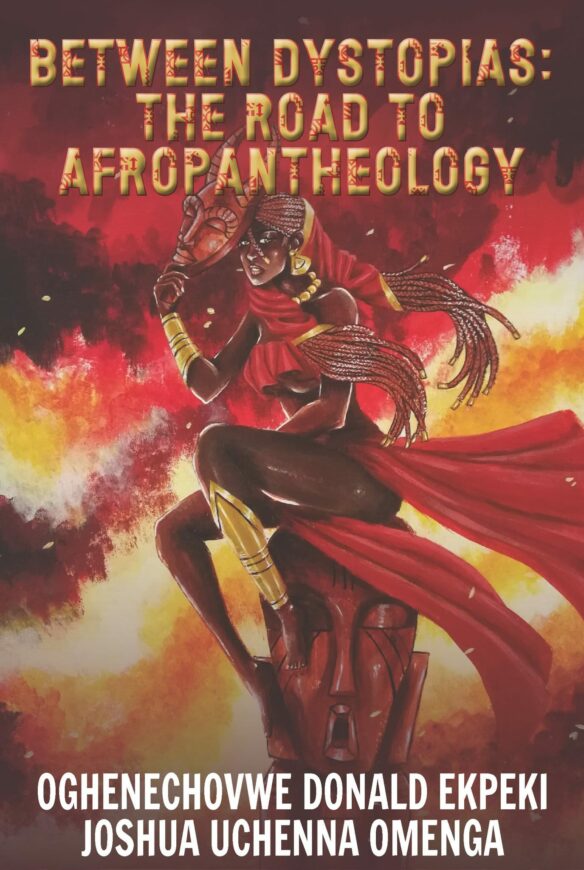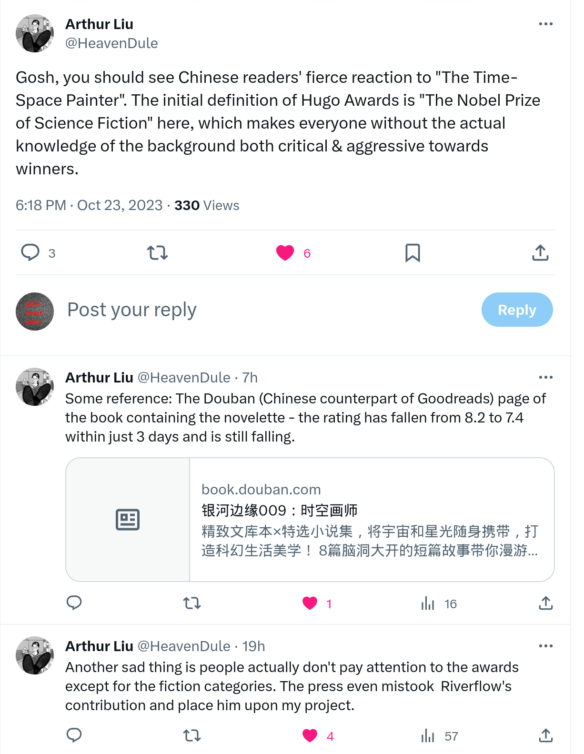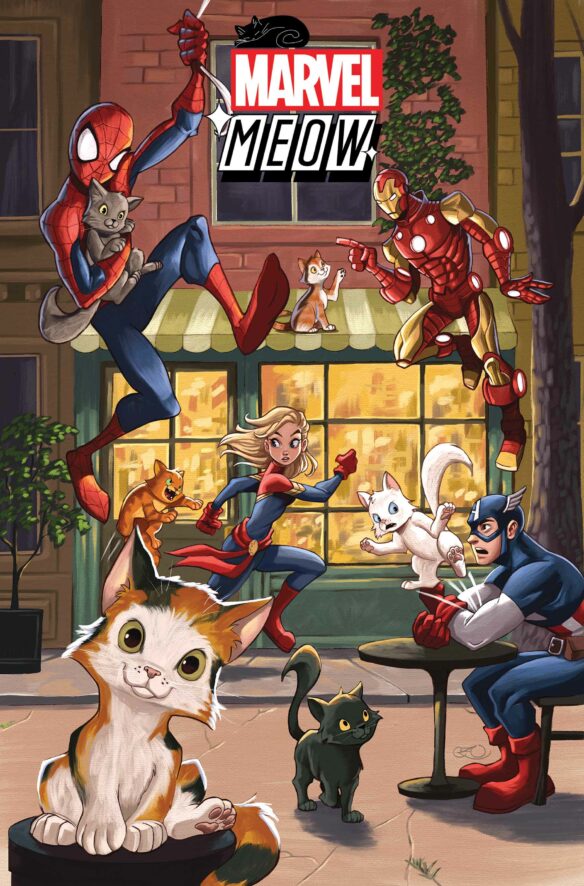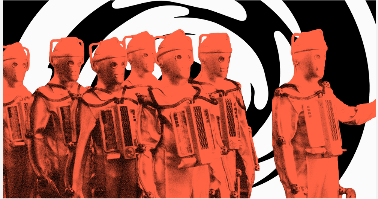(1) WELL, I’M BACK. That’s one of many things the Fourteenth Doctor doesn’t say in this video. Let Collider explain to you the way a new “’Doctor Who’ Featurette Breaks Down How David Tennant Returned”.
After an entire decade of not playing the role of the Doctor, David Tennant is back in Doctor Who, the classic BBC show about an alien who travels across time and space in a blue police box called the TARDIS. A new behind-the-scenes featurette released by the network shows how the team behind the series collaborated to film Tennant’s return to the titular role. Since a different crew was in charge of filming Jodie Whittaker‘s departure from the story, the team working with Tennant had to coordinate with the footage that had already been shot…
(2) 2023 WSFS BUSINESS MEETING VIDEOS. [Item by Kevin Standlee.] The video from the 2023 WSFS Business Meeting is now uploaded to YouTube.
The room was under-lit. I tried to compensate in the camera settings and in post-production, but the videos still came out darker than I would have liked.
The meeting was conducted in English and Chinese, with simultaneous translation through headsets. There was no mechanism for combining those translation feeds with this video.
There was CART transcription in both English and Chinese, but it was computer generated and computer translated, which means it was not all that accurate. In some cases, we tried to swing the camera around to pick up the approximate English translation, but we did not manage to do so in all cases, especially when I wasn’t operating the camera, which I was unable to do when I was presiding over the meeting as the deputy presiding officer.
These videos are CC-attribution licensed, so if anyone wants to create translations, they are welcomed to give it a try as long as they apply the same CC licensing.
(3) CHENGDU WORLDCON ROUNDUP. [Item by Ersatz Culture.]
Taiyo Fujii on Chengdu hotel arrangements
This is an interesting observation, which perhaps Filers who attended Chengdu in person can comment on. (Very minor manual cleanups for style and grammar.)
I seemed to meet with non-Anglophone writers whilst at Chengdu. This was because the hotels were separated.
Guests stayed in separate hotels. One was the Sheraton which was close to the Chengdu Science (SF) Museum, and the other was the Wyndham, which was 30 mins from the venue.
The WSFS committee, exhibitors, foreign nominees, members from the USA and UK, and elderly visitors stayed in the first one, whereas others stayed at the latter.
[At the latter] I met many Chinese people, and writers from Asia, Europe, South America and other regions.
#worldcon
Note: Chinese laws require hotels to register foreign guests with the authorities, and a number of smaller locations won’t accept such guests, not through xenophobia (probably), but because they don’t have the systems or trained staff to handle the bureaucratic aspects. I don’t think that’s too relevant here – I assume all of the hotels associated with the con would be set up to handle foreigners – but may be a partial explanation as to why the con organizers were so involved in accommodation for invited attendees, to avoid potential bad press if attendees were turned away from a hotel.
Con commentary
File 770 contributor SanFeng aka Feng Zhang links to a Chinese-language newspaper report, which contains quotes from him, and adds his own thoughts in this Weibo post. (Via Google Translate, with minor cleanup edits.)
Me and West China Metropolis Daily reporter Zhang Jie chatted very happily. This passage really basically sums up my main feelings about attending the Worldcon this time. Of course, the “multi-layered” conference is bound to have various conflicts, contradictions, and inconsistencies. I also heard and experienced a lot. The main problem is that the needs of science fiction fans are not a high priority, which lead to some misplaced expectations and reality. Anyway, we thank Chengdu for hosting this event! Looking forward to the next meeting.
Photos from the other SF con that took place in Chengdu last weekend
(Via SF Light Year/Adaoli) I think these are the events that took place at the Sheraton, rather than the SF museum, under the banner of the 6th China (Chengdu) International SF Convention, that was originally scheduled for 2021, but got cancelled due to COVID. (If you remember the item last month about a bean paste tie-in, it was technically connected to this event, rather than the Worldcon proper.)
The QR code shown here should link to https://y.camera360.com/photolive/collection?channel=pc&origin=link&collectId=20231020204417122

I haven’t actually looked at more than a couple of these photos, because for me it took several minutes to show anything other than a loading spinner.
Xiaohongshu images
Now that the con is over, lots of people are uploading their photos. These are but a small sampling of the posted photosets.
- Ribbons
- Tables and panels
- Schedule for the opening ceremony, ribbons, and other stuff
- Hugo Ceremony
- Badges and volunteer uniform for sale
There are even more photos taken with faces familiar to Filers, or people who are Filers themselves. I’ve not had chance to go through them all yet, but I’ll try to include them in the next day or so.












(4) BIRD AND BABY BOUGHT. “Eagle and Child: Tolkien and Lewis pub bought by tech institute” – BBC News has the story.
An Oxford pub that was frequented by authors CS Lewis and JRR Tolkien has been bought by a research institution building a campus in the city.
The Ellison Institute of Technology (EIT), founded by US tech billionaire Larry Ellison, said it had bought the Eagle and Child, which shut in 2020.
The pub in St Giles’ dates back to 1650 and has a plaque inside commemorating the writers’ get-togethers.
EIT said it would “refurbish and reopen the iconic venue”….
…. The company’s founding director and CEO, Dr David Agus, said: “The Eagle and Child pub is a truly historic venue that has hosted some of the greatest minds Oxford has had to offer for over 300 years.
“We are humbled and proud to be able to safeguard this treasured pub’s future and continue its legacy as a place for brilliant people to come together, including for our Ellison scholars.”
(5) AFROPANTHEOLOGY ANTHOLOGY. Between Dystopias: The Road To Afropantheology edited by Oghenechovwe Donald Ekpeki and Joshua Uchenna Omenga has been released. It’s available as an eBook (direct from Publisher, MOBI & EPub) a trade paperback from Amazon, a trade paperback from Barnes and Noble, a trade paperback from Books a Million and almost everywhere else.

(6) FIVE BY FIVE. Charlie Jane Anders names “Five sci-fi and fantasy novels to read now” in the Washington Post. Thanks to a gift link you can read it there. Authors of these books are Cassandra Clare, Samit Basu, micha cárdenas, B. Pladek and Alix E. Harrow.
One theme animates many recent science fiction and fantasy books: What happens when an outsider enters the corridors of power? Not every orphan with special powers ends up saving the world. The heroes of these new books make their way into rarefied circles and encounter the snares of politics. In the process, they give us new insights into what happens when an ordinary person rises to greatness….
(7) EATING THE FANTASTIC. Scott Edelman invites listeners to chat and chew over fried calamari with Michael Marano in Episode 210 of his Eating the Fantastic podcast.

This time around my guest is Michael Marano, winner of both the Bram Stoker Award and the International Horror Guild Award for Best First Novel for Dawn Song, published by Tor Books in 1998. His short fiction has appeared in the anthologies Outsiders: 22 All New Stories from the Edge, Dark Fusions: Where Monsters Lurk, The Outer Limits, Volume Two, Peter S. Beagle’s Immortal Unicorn, and others. His novella “Displacement” was nominated for a 2011 Shirley Jackson Award. Some of his short fiction has been gathered in the collection Stories from the Plague Years from Cemetery Dance Publications.
Michael’s also a journalist who went on many junkets for me back when I edited science fiction media magazines. His non-fiction has appeared in alternative newspapers such as The Independent Weekly, The Boston Phoenix, and The Weekly Dig, plus his column “MediaDrome” has been a popular feature in Cemetery Dance magazine since 2001. He’s a writing teacher as well, which you’ll hear all about in this episode. Plus, he’s an aerialist who’s done performances inspired by a variety of science fiction greats. That’s an art form I’ve never had the chance to discuss before, so that’s where our conversation began.
We discussed how his love of science fiction storytelling led him to explore wrestling and roller derby, the lessons we each learned from our early rejections, his preference for old school Dungeons & Dragons, how his crush on Linda Blair affected his first celebrity interview, whether writers ever really retire regardless of what they claim, what his career as a film critic taught him about the possible arc of his fiction writing career, and much, much more.
(8) BRO GUY SIGHTING. [Item by Mark Roth-Whitworth.] Brother Guy was on C-SPAN3 Saturday talking about storytelling, science and religion. Here is a link to video of his talk – “The Pope’s Astronomer on Astronomy and Faith”.
Known as the pope’s astronomer, Vatican Observatory director and author Brother Guy Consolmagno considered how the art of storytelling can illuminate both astronomy and religious faith. Friends of the North Hollywood Library in Los Angeles hosted this program.
(9) MEMORY LANE.
2007 — [Written by Cat Eldridge from a suggestion by Mike Glyer.]
Michael Chabon’s The Yiddish Policemen’s Union is the source of our Beginning for this Autumnal Scroll. But let’s talk about the writer now.
I first encountered him by way of his Summerland novel, possibly the best fantasy ever written about baseball. It won the Mythopoeic Fantasy Award for Children’s Literature though I think that it is a book for individuals of all ages.
From there I then moved unto The Gentlemen of the Road which is genre by virtue of being alternate history. The only long work that I’ve not read by him that I probably should is The Final Solution: A Story of Detection, a Sherlock Holmes novella or short novel depending on your viewpoint. Anyone here that has read it?
Yes, I’m skipping a lot of his work here obviously including being a scriptwriter for genre series and films as that’d take more space here than is really warranted. Do feel free to take me to task for what I should’ve mentioned here that I didn’t.
And that brings me to The Yiddish Policemen’s Union which had its first English language publication by HarperCollins sixteen years ago. It actually had its first publication in Dutch as De Jiddische politiebond on Manteau previously the same year
It would win a Hugo at Devention 3 along with a Nebula and a Sidewise, very impressive indeed.
See no spoilers? Now here’s the Beginning…
Nine months Landsman’s been flopping at the Hotel Zamenhof without any of his fellow residents managing to get themselves murdered. Now somebody has put a bullet in the brain of the occupant of 208, a yid who was calling himself Emanuel Lasker.
“He didn’t answer the phone, he wouldn’t open his door,” says Tenenboym the night manager when he comes to roust Landsman. Landsman lives in 505, with a view of the neon sign on the hotel across Max Nordau Street. That one is called the Blackpool, a word that figures in Landsman’s nightmares. “I had to let myself into his room.”
The night manager is a former U.S. Marine who kicked a heroin habit of his own back in the sixties, after coming home from the shambles of the Cuban war. He takes a motherly interest in the userpopulation of the Zamenhof. He extends credit to them and sees that they are left alone when that is what they need.
“Did you touch anything in the room?” Landsman says.
Tenenboym says, “Only the cash and jewelry.”
Landsman puts on his trousers and shoes and hitches up his suspenders. Then he and Tenenboym turn to look at the doorknob, where a necktie hangs, red with a fat maroon stripe, already knotted to save time. Landsman has eight hours to go until his next shift. Eight rat hours, sucking at his bottle, in his glass tank lined with wood shavings. Landsman sighs and goes for the tie. He slides it over his head and pushes up the knot to his collar. He puts on his jacket, feels for the wallet and shield in the breast pocket, pats the sholem he wears in a holster under his arm, a chopped Smith & Wesson Model 39.
“I hate to wake you, Detective,” Tenenboym says. “Only I noticed that you don’t really sleep.”
“I sleep,” Landsman says. He picks up the shot glass that he is currently dating, a souvenir of the World’s Fair of 1977. “It’s just I do it in my underpants and shirt.” He lifts the glass and toasts the thirty years gone since the Sitka World’s Fair. A pinnacle of Jewish civilization in the north, people say, and who is he to argue? Meyer Landsman was fourteen that summer, and just discovering the glories of Jewish women, for whom 1977 must have been some kind of a pinnacle. “Sitting up in a chair.” He drains the glass. “Wearing a sholem.”

(10) TODAY’S BIRTHDAYS.
[Compiled by Cat Eldridge.]
- Born October 25, 1939 — Fred Marcellino. Among all our writers this time, we have an illustrator. And what an illustrator he was. He did the Antheum cover of McCaffrey’s Dragonsong and several other Pern covers as well, along with Mark Helprin’s Winter’s Tale, Iain Banks’ The Wasp Factory and Rat Bradbury’s Death Is A Lonely Business to name but a few of the covers that he’s illustrated. (Died 2001.)
- Born October 25, 1940 — Janet Fox. Author whose stories appeared in countless genre zines and anthologies between the Seventies and mid-Nineties. Her long fiction, mostly the Scorpio Rising series, was done as Alex McDonough. She’s also known for the Scavenger’s Newsletter which featured a number of noted writers during its long including Linda Sherman, Jeff VanderMeer and Jim Lee. (Died 2009.)
- Born October 25, 1963 — John Gregory Betancourt, 60. Writer best known most likely for his work In Zelazny’s Amber universe but who has written quite a bit of other franchise fiction including works in the Star Trek, Hercules, Robert Silverberg’s Time Tours, Dr. Bones and The New Adventures of Superman. Most of his original fiction was early in his career. He’s also edited in a number of magazines including Weird Tales, Amazing Stories, H. P. Lovecraft’s Magazine of Horror, Adventure Tales and Cat Tales. He even co-edited with Anne McCaffrey, Serve It Forth: Cooking with Anne McCaffrey. His Wildpress Press has been nominated three times for World Fantasy Awards.
- Born October 25, 1969 — Cecil Castellucci, 54. Canadian rock musician who performs under the name of Cecil Seaskull. I’m giving her a Birthday shout-out for two very different works, the first being The Year of the Beasts co-written with Nate Powell which used the Medusa myth as its story basis, and Tin Star, a romance tinged space opera set on a remote space station. All of work is YA in nature.
- Born October 25, 1971 — Marko Kloos, 52. Author of two MilSF series, Frontlines and The Palladium Wards. His Lines of Departure was nominated for Hugo Award for Best Novel at Sasquan on a slate organized by the Sad Puppies. In reaction to this, Kloos withdrew the novel from consideration for the award. He was subsequently honored by George R. R. Martin for this decision. And that gets him Birthday Honors. Four of his books have been Dragon Awards nominees in the Best Military SF or Fantasy category.
- Born October 25, 1971 — Elif Safak, 52. Turkish writer of three genre novels, one written originally in Turkish (Mahrem), The Gaze in its English translation, and two written in English, The Architect’s Apprentice (which was translated into Turkish as Ustam ve Ben) and 10 Minutes 38 Seconds in This Strange World.
- Born October 25, 1979 — Kristian Bruun, 44. Canadian actor best known for his long-running role as Donnie Hendrix on the Hugo- and Emmy-winning SF drama Orphan Black, where he was one of the main sources of (usually dark) comic relief. He also starred in the SF Rom-Com Red Rover opposite The Expanse regular Cara Gee, had minor recurring roles in A Handmaid’s Tale and Snowpiercer, and appeared in the Inuit SF film Slash/Back, among other genre roles. (Xtifr.)
(11) COMICS SECTION.
- The Far Side is a tale of betrayal at night. (Da da daaah!)
- Saturday Morning Breakfast Cereal is about the self-esteem bot.
(12) FREEDOM OF EXPRESSION AWARD. A $10,000 prize — “Penguin Random House launches high schoolers’ award to combat book bans”. The Guardian has details.
Publisher Penguin Random House has launched a new writing award in the US celebrating freedom of expression in response to a rise in book bans across the country.
The Freedom of Expression award invites applicants to write about one banned book that changed their life and why. The $10,000 (£8,168) prize will be awarded to a high-school student planning to attend university in 2024.
“In the midst of censorship efforts, it’s crucial that we protect and celebrate freedom of expression, especially for young people whose voices we need and want to lift up now more than ever,” said Claire von Schilling, director of corporate communications and social responsibility at Penguin Random House.
Book bans in US public schools increased by 33% over the last school year according to a September report by Pen America. It found that the authors whose books were targeted were most frequently women, people of colour and LGBTQ+ individuals.
Some of the books banned in more than 20 districts include The Bluest Eye by Toni Morrison, A Court of Mist and Fury by Sarah J Maas, Gender Queer: A Memoir by Maia Kobabe and The Perks of Being a Wallflower by Stephen Chbosky. This report followed an American Library Association study which found that attempts to censor materials in school, academic and public libraries reached a record high in the first eight months of 2023….
(13) MEDIEVAL ROAD TRIPPER. “Chaucer goes digital as British Library makes works available online” reports the Guardian.
The entire collection of Geoffrey Chaucer’s works held by the British Library is being made available in digital format after the completion of a two and a half year project to upload 25,000 images of the often elaborately illustrated medieval manuscripts.
In a “major milestone” for the library, which holds the world’s largest surviving collection of Chaucer, it is hoped the digital platform will enable new research into the 14th-century poet, courtier, soldier, diplomat, and MP who is most famous for his Middle English epic, The Canterbury Tales.
Chaucer, who died in about 1400, was proclaimed by his contemporary poet Thomas Hoccleve as the “firste fyndere of our fair language” and is widely regarded as the father of English poetry. He was, in essence, the first poet laureate, being rewarded by Edward III with a gallon of wine daily for an unspecified task, thought to be for poetic work or works. He was also the first to be buried in what became Poets’ Corner in Westminster Abbey.
The British Library holds more than 60 items related to his works and life, and has now digitised them all….
(14) MST3K NEEDS $$$. “Mystery Science Theater 3K readies the Satellite Of Love for season 14” says AV Club. (The fundraiser link is here.)
Mystery Science Theater 3000, the little puppet-based movie commentary show that could, turns 35 this year (not counting the KTMA years), and The Mads are preparing another round of underseen crappy movies for our heroes to laugh at. But, aside from Tom Servo’s inevitable but unannounced presidential campaign next year, the Gigzmoplex has more surprises in store.
Earlier today, host and creator Joel Hodgson announced that financing for season 14 has begun. As anyone clicking on an article about MST3K knows by now, the show is a crowdfunded endeavor these days, a business decision that has paid dividends for MSTies. Following two revival seasons on Netflix, Mystery Science Theater took its future into its own hands and launched the Gizmoplex, an online viewing and community hub that hosted the crowdfunded season 13, which raised a staggering $6.5 million. What can we say? People really like Crow….
(15) IT’S LIFE JIM. [Item by SF Concatenation’s Jonathan Cowie.] 30 years ago research was published that a space probe detected life on a planet and there were also the signs of a technological civilization!
The journal Nature has just looked back on this groundbreaking experiment in an editorial and also an essay.
One of the researchers’ lead scientists was the legendary Carl Sagan, and the space probe that detected the life and techno-signs was NASA’s 1989-launched Galileo that, having been taken into Earth orbit by the space shuttle Challenger, was heading off to Jupiter. However, to get there it would need gravitational assists from both Venus and the Earth to acrue the necessary velocity to get to Jupiter in 1995.
As it was getting its gravitational assists from the Solar system’s inner planets, it passed 960 kilometres of Earth and Carl Sagan convinced NASA to use the probe’s instruments to look for signs of life on Earth.
The probe detected both methane and oxygen in the Earth’s atmospheres, a chemical mix that was in disequilibrium due to life. It also detected, in the red part of the spectrum, absorption characteristics of oxygenic photosynthesis. Finally, it detected modulated radio signals.
The reason this research is worth remembering today is that though 30 years ago no exoplanet had yet been discovered; today we have over 5,500 and counting. Today, we are also about to get data from the James Webb Space Telescope on the atmospheric composition of some of these exoplanets and it may be one of more exhibits disequilibrium.
As Nature notes, at the time the journal’s editors were in two minds as to whether to publish Sagan’s research – after all, we already knew that there was life on Earth. However, as a proof-of-capability and as a controlled experiment, the Sagan team’s work underpins that which will inform the forthcoming James Webb Space Telescope data.

Meanwhile Galileo went on to discover a beneath-the-ice ocean on Jupiter’s moon Europa. And now we have ESA’s Jupiter and Icy Moons Explorer (JUICE) mission heading out to Jupiter to see – among other things – what chemicals there are on Europa and whether these might be signs of life in Europa…
[Thanks to Ersatz Culture, John King Tarpinian, Chris Barkley, Mark Roth-Whitworth, Lise Andreasen, Kevin Standlee, Jennifer Hawthorne, Steven French, Cat Eldridge, SF Concatenation’s Jonathan Cowie, Mike Kennedy, and Andrew Porter for some of these stories. Title credit belongs to File 770 contributing editor of the day Daniel Dern.]













